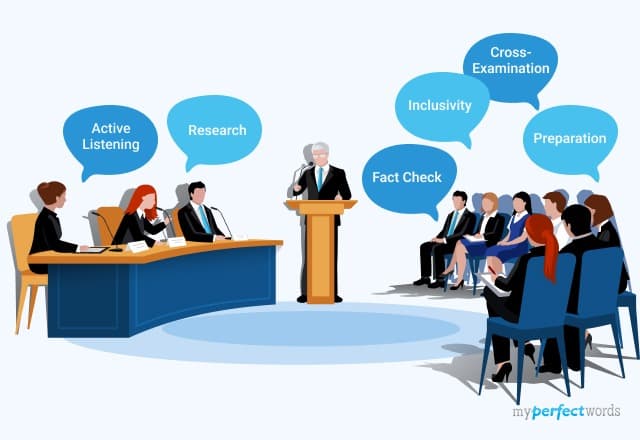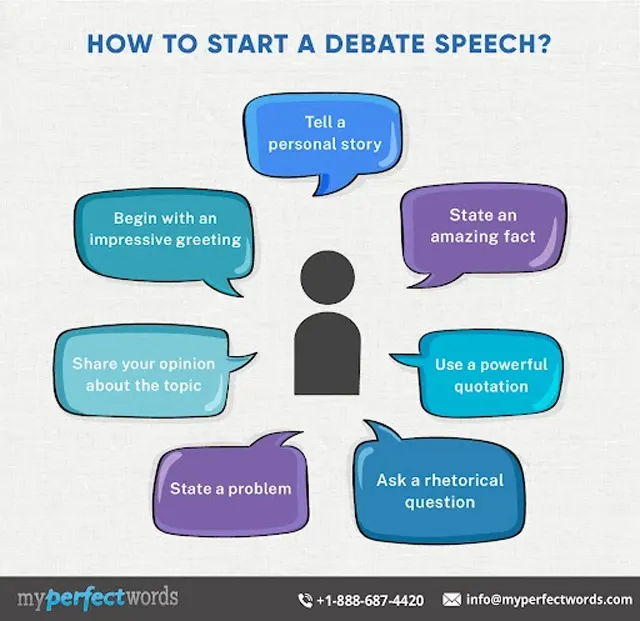Have you ever found yourself at a loss for words when it comes to articulating your thoughts in a debate?
The inability to formulate your thoughts in a debate can be a significant obstacle, hindering your ability to express yourself effectively. But don’t worry!
If you’re someone who’s wandering around trying to find the secrets to craft an outstanding debate speech, we’ve got your back.
In this blog, we’ll introduce you to debate writing, types, format, some tips, and debate examples, so you can understand how to pen down the perfect debate.
Let’s get going!
On This Page![]()
- 1. What is Debate Writing?
- 2. Types of Debate
- 3. Debate Writing Format
- 4. How to Write a Debate?
- 5. How to End the Debate?
- 6. Debate Writing Tips and Tricks
- 7. Advanced Techniques for Debate Writing
- 8. Debate Writing Examples
- 9. Debate Writing Topics for Students
What is Debate Writing?
The meaning of debate is a formal discussion on a particular topic where opposing arguments are presented. It involves presenting and defending ideas, critically evaluating different viewpoints, and seeking to persuade others.
In this context, the speaker takes a position either supporting or opposing a specific topic. Additionally, it involves the process of researching, preparing, and drafting the debate before presenting it formally.
Features of Debate Writing
The following are the main features of debate writing.
- Informative - A good debate must provide complete information and facts. It is supposed to inform and educate people with the help of logical reasoning
- Well-reasoned - The arguments discussed in a debate must be logical, relevant, competent, and well-explained.
- Persuasive - A debate must emphasize strong arguments to convince the people
- Orderly - A debate must present the facts in a structured and organized form. It should also follow a specific format
- Dynamic - In a debate, two teams present opposing arguments. Similarly, all the important points must be questioned and answered by each team member
Types of Debate
The following is a detailed description of common debating types that are practiced on various occasions.
- Team Policy Debate - It consists of two teams, each with two debaters. The main aim is to present a huge amount of data coherently
- Cross-examination Debate - It is considered a period between speeches. Here, the opponents ask each other to clarify and understand the points based on evidence
- Lincoln-Douglas Debate - It is a one-on-one and an open-style debate. Here, the debaters focus on arguing for or against a topic persuasively and logically
- Spontaneous Argumentation - Includes two teams that argue on a specific idea, but it does not require much research work. Similarly, this debate focuses more on presentation than content
- Public Forum Debate - It includes arguments on controversial topics. Moreover, these are used to test the argumentation, cross-examination, and refutation skills of the debaters
- Parliamentary Debate - It consists of two teams, one called the government and the other called the opposition team. The Government team proposes a motion, and the Opposition team argues against it
If you want to learn more about the different debating types, head to over comprehensive blog on types of debates.
Debate Writing Format
The debate writing for middle or high school follows the same format structure. Here, we have mentioned a detailed format for you to get an idea of the parts of a debate.
Opening Statements and Clarification It includes opening sentences with three key arguments and clarifying questions. Pro Team - 5 minutes Rebuttals In this section, the debaters repeat and analyze the opponent’s arguments and position. Summary Here, the debaters will summarize their positions after detailed arguments with the opposing team. Similarly, it also allows them to explain why their opinion is best. Pro Team - 3 minutes After a detailed discussion, each team must answer the questions in a 20-minute-long session. |
Check out the given debate writing template to get help with structuring your debate.
How to Start a Debate?
When starting the debate writing process, the question “How to write a debate introduction?…” could come off as a daunting one, but don’t worry.
Here are some easy steps for you to write a compelling debate introduction.
1. Impressive greeting and strong opening sentence:
Greet your audience with enthusiasm, capturing their attention with a compelling opening statement that sets the tone for your debate.
2. Tell a personal story:
Connect emotionally by sharing a relevant personal anecdote that humanizes the topic, making it relatable and engaging.
3. State an amazing Fact:
Introduce a surprising or impressive fact related to your debate topic to pique interest and establish credibility.
4. Use a powerful quotation:
Incorporate a thought-provoking quote that aligns with your argument, adding depth and authority to your speech.
5. Ask a rhetorical question:
Pose a rhetorical question to stimulate critical thinking among your audience, encouraging them to ponder the issue at hand.
6. State a problem:
Clearly articulate the problem or challenge associated with your debate topic, highlighting its significance and relevance.
7. Share your opinion about the topic:
Express your stance on the matter, providing a concise preview of your argument and setting the stage for the forthcoming points in your debate speech.
Here is a sample pdf showing debate introduction examples for students:
How to Write a Debate?
Following are the steps you can stick to for writing a debate speech in English that lets you stand out from the competition:
1. Understand the Debate
The first of many steps in debate writing is understanding its nature. Here, both teams will be given a topic, and they will choose an affirmative or negative stance.
2. Research the Topic Thoroughly
Brainstorm and research the topic thoroughly to understand all the aspects of the debate. Make a list of critical points and use credible sources to cover them in your key arguments.
3. Develop a Debate Outline
Develop a basic debate speech outline that consists of three main sections. It includes an introduction, body, and conclusion that are discussed below in detail.
- Debate Introduction
It is the first section of the outline that includes an attention grabber. Introduce your topic and present the context with the help of a thesis statement. Also, provide a brief overview of the students’ arguments to understand the direction of the debate.
- Debate Body
It is the main section of the debate that discusses the key arguments in detail. Moreover, it further includes logical reasoning and evidence to support the thesis.
- Debate Conclusion
The conclusion is the last chance to demonstrate significant ideas. It summarizes the main body by adding emotion and drama to the words and includes a strong closing sentence.
4. Writing the Debate
Start writing the final draft of your debate. Mention the crucial elements of persuasion, which are ethos, pathos, and logos. These are used to explain the effects of the resolution in the real world.
Also, use transition words to maintain a logical flow between paragraphs. Lastly, edit and proofread your work to avoid plagiarism, grammar, spelling, and punctuation errors.
Here is a great example of a well-written debate introduction:
| “Ladies and gentlemen, today's motion is 'Should virtual reality be integrated into the education system?' I'm [Your Name], opening for the affirmative side. We'll show how virtual reality can revolutionize education. Let's begin with our first argument.” |
If you’re thinking, “How to write a debate greeting?”, take a thorough look at the detailed steps below:
1. Address the Audience: 2. Express Gratitude: 3. Introduce Yourself: 4. Acknowledge the Opponent: 5. Establish Rapport: 6. Relevant Quote or Anecdote: 7. State the Motion or Topic: 8. Preview Your Position: 9. Enthusiasm: 10. Conclude the Greeting: Here's an example of a debate greeting following the steps above: “Ladies and gentlemen, honorable judges, my name is [Your Name], and I am honored to represent [Your School/Organization] in today's debate. I would like to extend my respect to the opposing team for their hard work. As we gather here to discuss the motion, 'Should students have homework?' I am excited to present our compelling arguments in favor of this crucial educational practice. With that said, let's delve into the key points that support our position.” |
If you have the question, “How to write a debate against the motion?” in mind, look at this step-by-step procedure below:
1. Understand the Motion: 2. Research and Gather Information: 3. Develop Your Arguments: 4. Organize Your Arguments: 5. Anticipate Counterarguments: 6. Use Evidence: 7. Address the Motion's Assumptions: 8. Craft Your Introduction: 9. Structure Your Speech: 10. Use Persuasive Language: 11. Rebut and Refute: 12. Provide a Conclusion: 13. Practice and Delivery: 14. Engage with the Audience: 15. Be Open to Questions: |
How to End the Debate?
End the debate by making sure that you have included the following elements. It will help you assess the credibility of your debate.
- Does your debate start with an interesting greeting?
- Does it provide original content, personal experience, and a call to action?
- Does the debate follow a proper format structure?
- Does it include the correct sentence structure?
- Does it maintain logical transitions to flow ideas from one paragraph to another?
- Have you proofread or revised it for common mistakes such as spelling, grammar, and punctuation?
- Does the debate mention your opinion about the given topic?
- Does the debate end with a powerful conclusion sentence to leave a lasting impact on the audience?
Debate Writing Tips and Tricks
Here are some amazing debate tips and tricks for you to write a perfect debate:
- It is better to know and prepare for a debate before starting it
- Conduct thorough research work to collect relevant data and draft creative arguments about the topic
- A writer should think relatively to identify the validity of significant claims
- Try to understand the formal debate through a variety of personal experiences
- Support the arguments with examples and evidence to make them more credible and authentic
- Also, consider the perspective of the judges and audience while making a critical argument
- Always structure your speech while keeping the time limits in mind
- Do not always disagree with the opponent’s arguments. Instead, you should take notes and think logically
- Build your case by keeping in mind all the possible objections that others can raise
- Never make the mistake of introducing new arguments in your closing section
Advanced Techniques for Debate Writing
Below are some easy debating techniques to write a primary and high school debate.
- Introduce the topic at the beginning of the debate and form an opinion about it.
- Know your audience to adjust your argument according to them.
- Assign the two sides as affirmatives and negatives.
- Take enough time to research the case and the vocabulary used for it.
- Organize your opinion and present supporting facts to persuade the audience.
- Follow a basic debate structure that includes the following period.
- Get an idea about the opponent’s arguments and advance your research by weakening them.
- Make a judgment based on the audience’s votes and your opinion about the arguments.
- Connect to the audience emotionally by presenting examples, evidence, and personal experiences.
- Incorporate simple, well-timed humor to engage and emphasize your argument effectively
Debate Writing Examples
Check out the following examples of debate writing to get a better idea of the concept.
If you want inspiration from more examples on various debate topics, visit our comprehensive debate examples blog!
Debate Writing Topics for Students
Check out the following debate writing sample pdf examples to get a better idea of the concept.
- All schools should conduct compulsory drug testing on their students
- Middle and high schools must ban sex education
- Is it ethical to move in before getting married?
- Academic institutes should ban smoking on college premises
- Peer pressure is harmful to students
- High schools should provide daycare services to students who have children
- The government should develop nuclear energy for commercial use
- Celebrities can get away with crime more easily than non-celebrities
- Cell phones should not be used in classrooms
- Money motivates people more than any other factor in the workplace
Head over to our list of debate topics to choose from a wide range of unique debate writing ideas.
To sum it up,
This comprehensive guide to debate writing will help you write a perfect one for your high school or college. We’ve covered all the essential details one would need to craft a winning debate.
However, if you think that you could use a helping hand to perfect your debate writing game, we’ve got you covered.
You can get help from our speech writing service to solve your debate writing worries. Our writing experts will deliver you comprehensive and well-composed debates at rates that won’t break the bank.
Simply reach out to us and request "write my essay for me" and we’ll take care of all your writing-related problems.
Frequently Asked Questions
What are the 4 pillars of debate?
The four pillars of debate are clarity, relevance, evidence, and rebuttal. Clarity ensures your argument is easy to understand, relevance keeps the argument focused on the topic, the evidence provides support, and the rebuttal addresses opposing points.
What are the 3 tips for debate?
The 3 important tips for debate writing are:
- Research thoroughly: Know your topic inside and out.
- Stay calm and composed: Present your arguments confidently.
- Listen actively: Respond effectively to your opponent's points.
What are keywords in a debate?
Keywords in a debate include terms like contention, rebuttal, cross-examination, affirmative, negative, burden of proof, and resolution. These terms help structure and guide the debate.

Write Essay Within 60 Seconds!
Use our AI tool to generate high quality essay
WRITTEN BY
Cathy A.
Cathy has been been working as an author on our platform for over five years now. She has a Masters degree in mass communication and is well-versed in the art of writing. Cathy is a professional who takes her work seriously and is widely appreciated by clients for her excellent writing skills.
Keep reading
A List of 190+ Debate Topics and Ideas

Debate Speech - Ultimate Writing Guide For Students
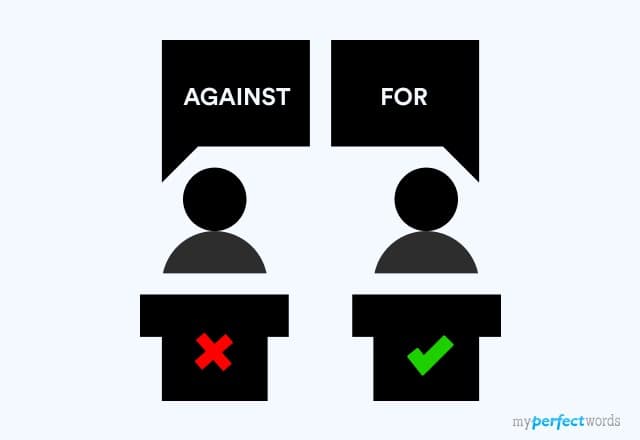
Types of Debate - A Complete Overview & Examples
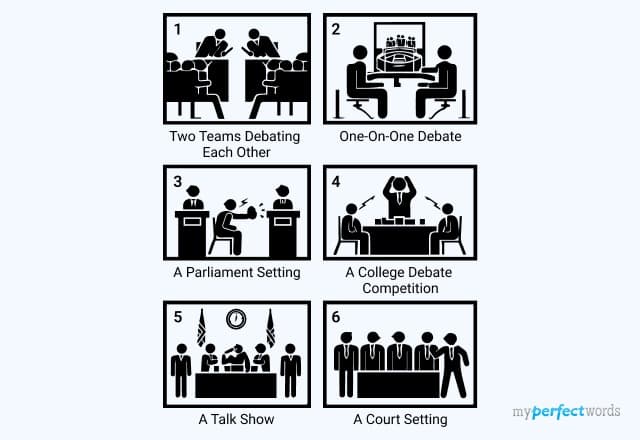
Free Debate Examples for All Academic Levels

10 Debate Tips and Tricks for Students
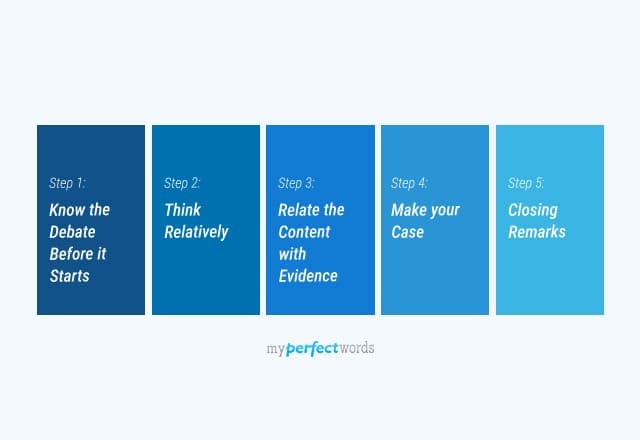
Advanced Debating Techniques For Students Of All Academic Levels
